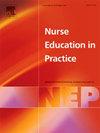Pathophysiology-medical History-signs and symptoms-Health assessment-Investigation-Treatment (PHsHIT): A mnemonic framework for development of clinical reasoning in nursing students: A quasi-experimental design
IF 3.3
3区 医学
Q1 NURSING
引用次数: 0
Abstract
Aims
To investigate how implementing the PHsHIT framework within a mind map concept and instructional approach could enhance learning experience, leading to enhanced self-perceived clinical reasoning abilities, self-confidence, and clinical decision-making skills among nursing students, while also reducing their levels of anxiety.
Background
Nursing graduates face challenges in applying clinical reasoning proficiently within their initial year of practice.
Methods
This study employed a quasi-experimental pretest-posttest design. Purposive sampling involving a total of 125 nursing students. The intervention group (n = 67) attended a 2-hour tutorial class using the PHsHIT framework, whereas the control group (n = 58) attended a standard tutorial class using conventional methods. Descriptive statistics, chi-square test, parametric between-participants and within-participants analyses of variance were conducted to compare the self-perceived clinical-reasoning ability, self-confidence and anxiety levels, and clinical decision-making ability of the two groups.
Results
At the post-training time point, a significant difference was observed between the two groups in terms of their clinical decision-making ability (MD = 1.18, SE = 0.35, p = 0.001), which suggested that the PHsHIT framework had a short-term training effect.
Conclusion
The PHsHIT framework exhibited short-term benefits for improving students’ clinical decision-making ability, and participants welcomed the method.
病理生理-病史-体征和症状-健康评估-调查-治疗(PHsHIT):护理学生临床推理发展的助记框架:一个准实验设计
目的探讨在思维导图概念和教学方法中实施PHsHIT框架如何提高护理学生的学习体验,从而提高自我感知的临床推理能力、自信心和临床决策技能,同时降低他们的焦虑水平。护理毕业生在第一年的实践中面临着熟练运用临床推理的挑战。方法采用准实验前测后测设计。目的抽样共涉及125名护生。干预组(n = 67)使用PHsHIT框架参加了2小时的辅导课,而对照组(n = 58)使用传统方法参加了标准的辅导课。采用描述性统计、卡方检验、参数化参与者间及参与者内方差分析比较两组患者自我感知临床推理能力、自信焦虑水平及临床决策能力。结果在训练后时间点,两组患者的临床决策能力差异有统计学意义(MD = 1.18, SE = 0.35, p = 0.001),说明PHsHIT框架具有短期训练效果。结论PHsHIT框架对提高学生的临床决策能力具有短期效益,参与者对此方法表示欢迎。
本文章由计算机程序翻译,如有差异,请以英文原文为准。
求助全文
约1分钟内获得全文
求助全文
来源期刊

Nurse Education in Practice
NURSING-
CiteScore
5.40
自引率
9.40%
发文量
180
审稿时长
51 days
期刊介绍:
Nurse Education in Practice enables lecturers and practitioners to both share and disseminate evidence that demonstrates the actual practice of education as it is experienced in the realities of their respective work environments. It is supportive of new authors and will be at the forefront in publishing individual and collaborative papers that demonstrate the link between education and practice.
 求助内容:
求助内容: 应助结果提醒方式:
应助结果提醒方式:


